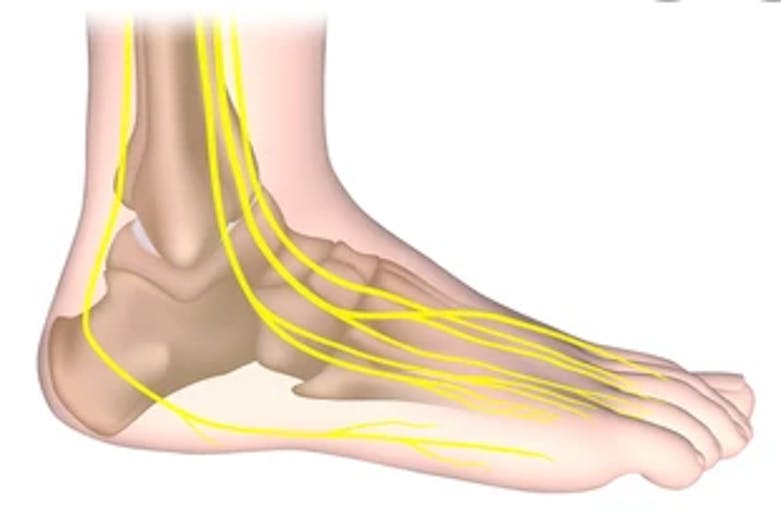Diabetic Neuropathy: How Elevated Glucose Levels Affect Your Feet
Ways to Maintain Healthy Feet and Prevent Injury
If you’re struggling with uncontrolled blood glucose levels, have you been surprised when you stepped on a nail or sharp object that your feet didn’t feel anything? Our sense of pain and touch is crucial to preserving our tissues and keeping our feet free from injury and infection.
Some people with diabetes struggle with tingling or burning feelings in their feet, as well as sharp pain or cramps. While others are extremely sensitive to touch. Socks, shoes as well as light bedsheets can cause severe pain. The symptoms are often worse at night.
These symptoms are part of diabetic neuropathy – when uncontrolled glucose levels affect the nerves and sensation. The feet and legs often are affected first, followed later by hands and arms.
If blood glucose levels remain elevated for prolonged periods, some people develop ulcers, poor wound healing and infections in their feet. Without treatment, such wounds can result in tissues dying, life-threatening infections and even require amputation of toes or feet. This can result in loss of freedom and independence – inability to walk, drive, and even confinement to a wheelchair.
Diabetic Neuropathy: Symptoms


What is Diabetic Neuropathy and How Does Blood Glucose Levels Affect It?
Diabetes is one of the leading causes of neuropathy. Nerve cells, called neurons, are damaged or destroyed when there are uncontrolled glucose levels. Over time, high blood sugar damages nerves and interferes with their ability to send signals, leading to a condition called diabetic neuropathy. In addition, high blood glucose levels weaken the walls of blood vessels that supply nerves with oxygen and nutrients they need to remain healthy.
There are different types of nerve cells. Sensory nerves carry messages from your five senses. In the case of our feet, there are nerves that detect the sensation of touch, pressure and temperature and communicate that to our brain. Motor nerves travel in the opposite direction of sensory nerves. They deliver messages from your brain to the muscles. If your foot stepped on a sharp nail, or piece of glass, the motor nerves would give signals to the muscles in your foot to move away from this painful object.


What Are Some Ways to Manage Diabetic Neuropathy and Prevent Injury to Feet?
Here are some ways to reduce your risk of diabetic neuropathy and damage to your feet.
1) Keep Your Floors Clear of Objects
2) Check Your Feet Every Day
Examine your feet and legs daily for blisters, infections, sores or wounds. You may not feel any pain, or notice any problems. However, visual inspection allows you to quickly act on infections or sores that cause serious health problems if left untreated. Also, use lotion on your feet if they’re dry. Also, inspect your toenails and ensure that they are well groomed and free of infections.


Be vigilant in keeping your floors clear of debris. Sweep, mop or vacuum your floor on a regular basis to remove objects that could cause tissue damage if lodged accidentally in your feet. Don’t’ walk barefoot especially when at home. Wear slippers at home to prevent accidentally stepping on objects.
3) Wear Socks and Shoes that Fit Well
If you are prediabetic or diabetic, finding shoes and socks that fit well are crucial to protecting your feet.
If you’ve noticed your feet experiencing changes such as foot color or temperature, nerve damage, blisters, or infections, your feet are especially vulnerable to damage. In addition, those with sweaty, moist feet, decreased pulses in the foot or peripheral artery disease would also benefit from diabetic socks.
Diabetic socks and shoes are designed to reduce the risk of blisters and ulcers that could cause serious damage in the feet. Diabetic socks can be found at your local pharmacy such as Walgreens or CVS. Also, these purchases may be eligible for FSA benefits as necessary healthcare equipment.
Diabetic shoes are also designed to protect vulnerable feet from ulcers and wounds. Brands such as Apex, Orthofeet and Propet create shoes and slippers for diabetics.




Privacy Policy
Privacy Policy
We will never send you spam messages!
Want More?
Enter your best email below and I’ll send you recipes to maintain healthy glucose levels
Balance Glucose Now is not associated with any of the official parent companies or merchants of any of the products it may suggest. Balance Glucose Now may receive a commission on products it promotes.
© Balance Glucose Now 2022
Copyright © 2022 Balance Glucose Now. All Rights Reserved.
Privacy | Terms | Earnings | DMCA | Contact
Disclaimer: These statements have not been evaluated by the Food and Drug Administration. This product is not intended to diagnose, treat, cure, or prevent any disease. This information is not intended to be a substitute or replacement for any medical treatment. Please seek the advice of a healthcare professional for your specific health concerns. Individual results may vary.
Marketing Disclosure: This website is a market place. As such you should know that the owner has a monetary connection to the product and services advertised on the site. The owner receives payment whenever a qualified lead is referred but that is the extent of it.
Advertising Disclosure: This website and the products & services referred to on the site are advertising marketplaces. This website is an advertisement and not a news publication. Any photographs of persons used on this site are models. The owner of this site and of the products and services referred to on this site only provides a service where consumers can obtain and compare.
Balance Glucose Now is not associated with any of the official parent companies or merchants of any of the products it may suggest. Balance Glucose Now may receive a commission on products it promotes.
